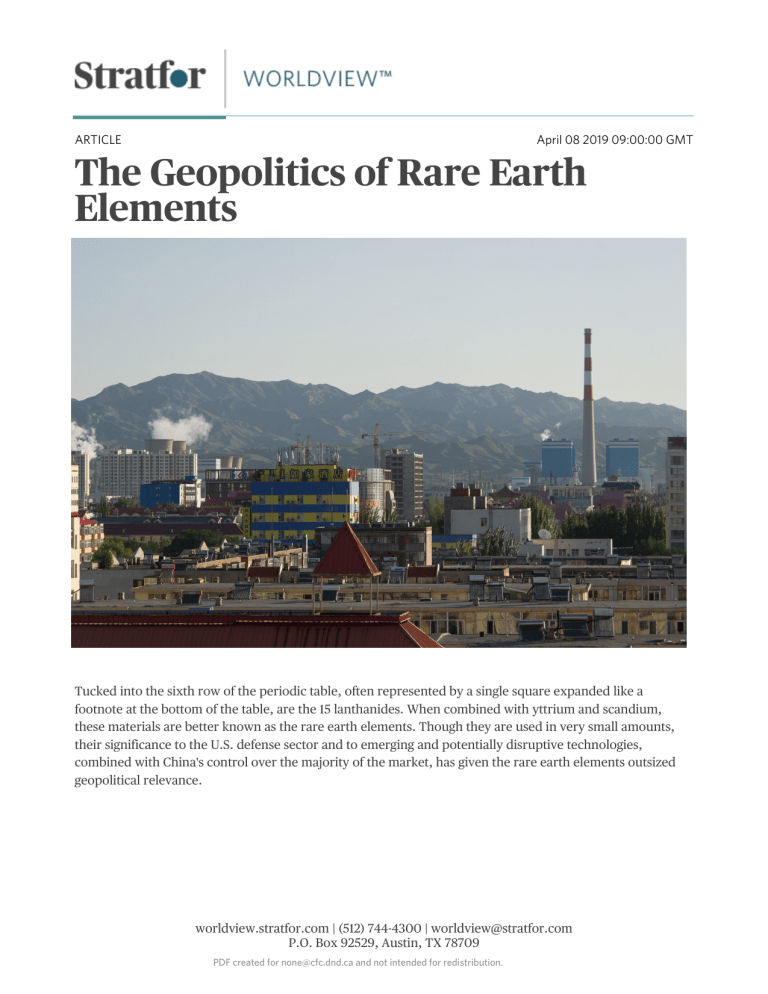The Geopolitics Of Rare Earths: A Looming Cold War

Table of Contents
The Strategic Importance of Rare Earths
Rare earth elements are not rare in the Earth's crust, but their economic extraction and processing present challenges, making them strategically crucial. Their unique magnetic, luminescent, and catalytic properties are essential components in countless modern technologies.
- Electronics: REEs are indispensable in smartphones, laptops, and other consumer electronics, powering their motors, displays, and other functionalities. Neodymium magnets, for instance, are crucial for the tiny but powerful motors in smartphones' vibration alerts.
- Clean Energy: The transition to renewable energy relies heavily on REEs. Wind turbines utilize powerful neodymium magnets for efficient energy generation, while electric vehicle (EV) motors also depend heavily on these critical minerals. This increased demand from the green energy sector significantly impacts the global REE market.
- Military Technology: REEs are vital for advanced military applications, including guided missiles, radar systems, and night vision technology. Their strategic importance in defense systems elevates the geopolitical stakes considerably.
- Medical Applications: MRI machines and other medical technologies also utilize REEs, showcasing their impact beyond consumer electronics and defense.
The irreplaceability of REEs in many of these applications underscores their economic value and strategic importance. The economic impact of REE scarcity is far-reaching, affecting multiple industries and potentially impacting global economic stability.
Global Distribution and Production Dominance
The global distribution of rare earth deposits is highly uneven. While REEs are present worldwide, their concentration in economically viable deposits is limited. China holds a dominant position, controlling a significant portion of global REE mining, processing, and refining.
- China's Hegemony: China's dominance in the REE supply chain is undeniable. They control a vast majority of global processing and refining capacity, giving them significant leverage in the global market.
- Other Significant Producers: While Australia, the United States, Brazil, and others possess REE deposits, their production capacity pales in comparison to China's. This imbalance creates significant vulnerabilities for nations heavily reliant on Chinese imports.
- Supply Chain Implications: This uneven distribution creates significant vulnerabilities in global supply chains. Disruptions to Chinese REE production or export policies could have devastating consequences for numerous industries worldwide.
China's Influence and Geopolitical Leverage
China's dominance in the rare earth sector gives it considerable geopolitical leverage. This dominance has been, and continues to be, utilized as a tool in diplomatic negotiations and trade disputes.
- Past and Present Examples: History shows instances where China has restricted or threatened to restrict REE exports to exert political pressure on other nations. This leverage underscores the need for diversified supply chains.
- Potential for Future Conflict: The potential for China to weaponize its REE dominance in future trade wars or geopolitical conflicts is a significant concern for many countries.
- Reliance on Chinese Imports: Nations heavily reliant on Chinese REE imports are particularly vulnerable to such pressure tactics, highlighting the need for diversification strategies.
Diversification Efforts and the Search for Alternatives
Recognizing the risks associated with over-reliance on China, many countries, including the US and EU, are actively pursuing strategies to diversify their REE supply chains.
- Increasing Domestic Production: Significant investments are being made to boost domestic REE mining, processing, and refining capabilities, reducing dependence on foreign sources. This includes exploring and developing new deposits and improving extraction techniques.
- Alternative Materials and Technologies: Research is underway to explore alternative materials and technologies that can replace REEs in certain applications, minimizing the need for these critical minerals. This is a long-term solution requiring significant investment in research and development.
- International Collaborations: International collaborations and agreements are being forged to secure access to REE supplies and to promote responsible sourcing and ethical mining practices. These partnerships are crucial for establishing resilient and transparent supply chains.
Environmental Concerns and Sustainable REE Production
The environmental impact of REE mining and processing is a significant concern. Traditional methods can be environmentally damaging, necessitating the adoption of sustainable practices.
- Responsible Sourcing and Ethical Mining: Ensuring responsible sourcing and ethical REE mining is crucial to minimize environmental harm and protect local communities affected by mining operations.
- Environmental Regulations: Stricter environmental regulations and initiatives are needed to curb the environmental impact of REE extraction and processing, promoting sustainable mining practices.
- Recycling and Reuse: Investing in REE recycling and reuse technologies is crucial for reducing the environmental footprint of the REE industry and securing a long-term supply of these critical resources.
Conclusion
The geopolitics of rare earths are shaping up to be a major challenge in the 21st century. The strategic importance of REEs, coupled with their uneven global distribution and China's dominant position, creates a volatile geopolitical landscape. The potential for conflict is real, and diversification efforts, coupled with sustainable practices, are crucial to mitigate these risks. We must advocate for responsible REE sourcing, support policies promoting diversification and sustainability in the rare earth sector, and demand transparency in supply chains. Ignoring the geopolitics of rare earths is not an option; proactive strategies are needed to avoid a new era of resource-driven conflict.

Featured Posts
-
 Jackbit Best Crypto Casino For 2025 A Bitcoin Casino Review
May 17, 2025
Jackbit Best Crypto Casino For 2025 A Bitcoin Casino Review
May 17, 2025 -
 May 16 Oil Market Report News And Price Analysis
May 17, 2025
May 16 Oil Market Report News And Price Analysis
May 17, 2025 -
 Ultraviolette Tesseract Everything You Need To Know About The New Electric Scooter
May 17, 2025
Ultraviolette Tesseract Everything You Need To Know About The New Electric Scooter
May 17, 2025 -
 Brutal Loss To Clippers Ends Knicks Playoff Push
May 17, 2025
Brutal Loss To Clippers Ends Knicks Playoff Push
May 17, 2025 -
 Creatine Benefits Side Effects And Who Should Use It
May 17, 2025
Creatine Benefits Side Effects And Who Should Use It
May 17, 2025
